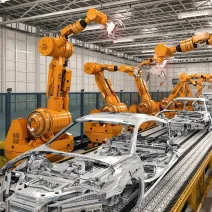Since some apps are time-critical, they must be executed exactly when they are expected to maintain the entire system functioning. An embedded systems engineer is responsible for designing, developing, and managing embedded systems in products. They work collaboratively with developers and provide technical assistance to clients and other departments. Embedded systems engineers also create and maintain documentation of projects and procedures. If you want to pursue a career in embedded systems development, you can become an embedded systems engineer. Engineering careers belong to the occupational field of architecture and engineering.

Finally, if the computed rates violate some of the rate constraints, some of the processes in the system are redesigned using information from the rate analysis step. We illustrate by an example how RATAN can be used in an embedded system design. The importance of embedded systems has led to the emergence of a strong industry that develops and uses them. Their criticality for services on all fronts and for technological and thus economic growth has led to significant efforts to address the challenges placed by embedded systems development and deployment. One important effort is the ARTEMIS initiative of the European Commission [1]. This program started with a Strategic Research Agenda (SRA) [8] and has grown to a significant activity, including a strong industrial association, named ARTEMISIA, which conducts research and development in the area of embedded systems.
Embedded system
The system designer may calculate the time required for service interpreters in the system and the time required by the scheduler to switch tasks. Such systems can fail to meet a system’s deadline, and the program is unaware of the missed deadline. CPU load can be naturally measured in a preemptive operating system by defining a lower priority process that does nothing except increment the counter. The hardware that runs an embedded operating system is usually quite resource-constrained. Embedded hardware systems are typically quite specific, and it means that these systems are designed to cover certain tasks due to limited resources. Arduino is an open source platform with a microcontroller that processes simple inputs, such as temperature or pressure, and turns them into outputs.

The TMS1000 series, which became commercially available in 1974, contained a 4-bit processor, read-only memory (ROM) and random-access memory (RAM), and it cost around $2 apiece in bulk orders. ASIC implementations are common for very-high-volume embedded systems like mobile phones and smartphones. ASIC or FPGA implementations may be used for not-so-high-volume embedded systems with special needs in kind of signal processing performance, interfaces and reliability, like in avionics. Many embedded systems are a small part within a larger device that serves a more general purpose. Often they constitute subsystems of other machines like avionics in aircraft and astrionics in spacecraft. Large installations like factories, pipelines and electrical grids rely on multiple embedded systems networked together.
Small Scale Embedded Systems
Laser printers have embedded devices that make use of systems to control various printing-related functions. Along with the primary function of printing, it also handles user inputs, errors, etc. In this advanced era, embedded systems’ basic applications have increased tremendously. They provide very embedded system definition useful devices and applications that are very time-saving and efficient. In embedded systems, the software typically resides in firmware, such as a flash memory or read-only memory (ROM) chip, in contrast to a general-purpose computer that loads its programs into random access memory (RAM) each time.

Consider using the checklists below to identify areas of focus for your study. Many ICs in embedded systems are VLSIs, and the use of the VLSI acronym has largely fallen out of favor. An early mass-produced embedded system was the Autonetics D-17 guidance computer for the Minuteman missile, released in 1961. When the Minuteman II went into production in 1966, the D-17 was replaced with a new computer that represented the first high-volume use of integrated circuits.
Network Embedded Systems
It is an arrangement in which all the unit combined to perform a work together by following certain set of rules in real time computation. It can also be defined as a way of working, organizing or doing one or many tasks according to a fixed plan. An embedded system is a system in which the computer (generally a microcontroller or microprocessor) is included as an integral part of the system. Want to keep learning about embedded systems and embedded systems development? Consider earning a certificate from an online specialization like Introduction to the Internet of Things and Embedded Systems.

A system is an arrangement where all its component work according to the specific defined rules. It is a method of organizing, working, or performing one or more tasks according to a fixed plan. QNX was created in 1980 and is a commercial embedded real operating system that requires the POSIX specification to compile.
Debugging embedded systems
In this chapter, we discussed a few challenges and their solutions in the context of testing embedded systems. In particular, we take a closer look into existing works on testing non-functional properties, such as timing, energy consumption, reliability, for embedded software. To put the existing works in perspective, we classify them in three distinct categories, based on the level of system abstraction used for testing.
Embedded System is a combination of computer software and hardware which is either fixed in capability or programmable. An embedded system can be either an independent system, or it can be a part of a large system. It is mostly designed for a specific function or functions within a larger system. For example, a fire alarm is a common example of an embedded system which can sense only smoke. Embedded Systems are made for their specific tasks that require specific programming and designing. Embedded system design has to be task-specific and well optimized to work and coordinate properly.
Real-Time Embedded Systems
The trace recording can be performed in software, by the RTOS, or by special tracing hardware. RTOS tracing allows developers to understand timing and performance issues of the software system and gives a good understanding of the high-level system behaviors. Trace recording in embedded systems can be achieved using hardware or software solutions.
- In this advanced era, embedded systems’ basic applications have increased tremendously.
- The 8080’s successor, the x86 series, was released in 1978 and is still largely in use today.
- Embedded systems often reside in machines that are expected to run continuously for years without error, and in some cases recover by themselves if an error occurs.
- People commonly wonder how an embedded system works since there is a high need for complex product technology, which provides opportunities for embedded software developers.
- For instance, debugging a single microprocessor system is different from debugging a system where processing is also done on a peripheral (DSP, FPGA, co-processor).
- As embedded systems get bigger, things that used to be only on general-purpose computers or even mainframes are now becoming common on embedded systems.
- A ship’s rudder without precise timing would not be able to reliably steer a ship.
Near-real-time approaches are suitable at higher levels of chip capability, defined by designers who have increasingly decided the systems are generally fast enough and the tasks tolerant of slight variations in reaction. In these instances, stripped-down versions of the Linux operating system are commonly deployed, although other OSes have been pared down to run on embedded systems, including Embedded Java and Windows IoT (formerly Windows Embedded). Numerous microcontrollers have been developed for embedded systems use.
Characteristics of an Embedded System
For instance, debugging a single microprocessor system is different from debugging a system where processing is also done on a peripheral (DSP, FPGA, co-processor). Embedded systems control many of the common devices in use today, such as card readers in hotel door locks or several things in a car. They can control small things like an MP3 player or a digital camera, and large things like traffic light systems, airplanes, or assembly lines in a factory. The Embedded system industry is foreseen to grow swiftly and driven by potential tech developments include virtual reality, augmented reality, artificial intelligence, deep learning, machine learning, and IoT. Embedded systems will be the main component of these upcoming technologies to make them more efficient and accurate. Like the name given, standalone embedded systems can function entirely without a hosting system.

